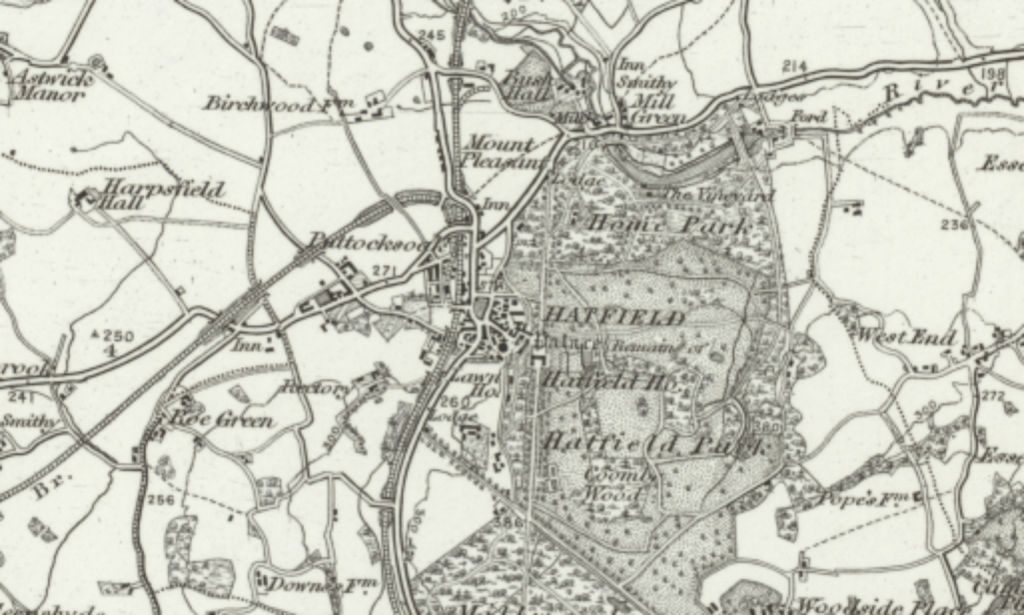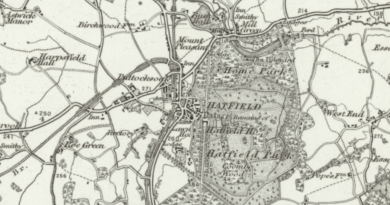Books about Hertfordshire
BOOKS ABOUT HERTFORDSHIRE
The Origins of Hertfordshire by Tom Williamson is a large 270 page book which covers the history of the county from late prehistoric times to the thirteenth century. There’s lots of topographical history of the county, a subject not always well covered by books looking at this period of the county’s history. Primarily text based, as the period covered inevitably means that there is limited documentary evidence, there are though a number of maps. The book’s ISBN is 9781905313952.
The Buildings of England – Hertfordshire book is the Bible of building archaeology in England, initially edited by the astute Nikolaus Pevsner, with research support from Bridget Cherry. The book has been recently updated by James Bettley and is 720 pages full of tightly written text about the buildings of Hertfordshire, in tremendous detail. There are many perambulations around the county’s towns, covering the main buildings of note. Pevsner’s quite cutting remarks about some buildings have remained in the book and there are some initial chapters about the general history of the county. The book’s ISBN is 9780300223903.
The Watford to St. Albans Branch by SC Jenkins is part of the Locomotion Papers from the Oakwood Press. It’s a 90 page book which has an in-depth history of the line, with plenty of photos of stations, engines and also numerous older timetables and maps. There’s a great deal of clarity to the writing and plenty of history, despite this being a relatively short branch line. The book’s ISBN is 0853613990.
Branch Lines Around Hertford and Hatfield to Broxbourne, St. Albans and Buntingford by Vic Mitchell and Keith Smith was published by Middleton Press in 2009. There are around 100 pages in the book, with Middleton being one of the prolific publishers of titles about the railway network. This title covers the evolution of the electrified branch line to Hertford East, along with the country branch to Buntingford. There’s not a substantial amount of supporting text, but the photos are interesting to look at, especially given how much has changed over the decades. There are also two pages of timetables, from the 1860s to the 1950s. The book’s ISBN is 9781906008581.
The Origins of Hatfield Street Names compiled by Frank J Cox is a 16 page book which details how all of the streets in the town of Hatfield acquired their names. The book was published by Hatfield This Century, now the Hatfield Local History Society. The reasons for the name of Fiddle Bridge Lane are intriguing, it’s likely linked to the story of a merry fiddler from the medieval period.
Hertfordshire Churches and Other Places of Worship by Jeffery W Whitelaw is 140 pages long and is something of a basic introduction to the historic religious buildings in the county. The book starts with a history of the local parish, with a chapter on the Cathedral and Abbey Church of St. Alban, with the book having an introduction by the Bishop. There’s then a section of post-conquest churches and monasteries up to the Reformation, then a chapter which covers the post-Reformation period. The next two chapters cover what to look for inside a church, then what to look for outside a church, along with a glossary of terms and then a gazetteer of the county’s churches. The book’s ISBN is 0948353856.
Hertfordshire Buses by John Law is a 96 page book published by Amberley which has tens of photos of older coaches from the 1930s to today. Between the 1930s and the 1960s the buses were operated by London Transport, before being handed to the National Bus Company in 1969. Bus deregulation in the 1980s led by Margaret Thatcher saw it split into numerous smaller companies. There’s plenty of supporting text under each photo and it’s a well-written title. The book’s ISBN is 9781445669717.
Hatfield and Its People – Part 5 : Roads and Railways was published in 1960 and was written by members of the Hatfield Branch of the Workers’ Educational Association. It’s a comprehensive 32 page book about primarily the evolution of the road system and the railways.
Hatfield and Its People – Part 8 : Schools was published in 1962 and was written by members of the Hatfield Branch of the Workers’ Educational Association. It’s a short 32 page book which is nearly entirely about the Countess Anne foundation. The initial text of the book apologises about the omission about most other schools in the area, although they are very briefly listed. Unfortunately, the title of the book is perhaps a little misleading given how it is so focused on one institution, but it does cover this subject with some clarity.
Hatfield and Its People – Part 11A : Families and Trades was published in 1964 and was written by members of the Hatfield Branch of the Workers’ Educational Association. It’s a 46 page book is inevitably a little niche given the broad subject being covered, which is the story of Hatfield’s trade and business families.
NO IMAGE
A Walk Around Old Hatfield by Gladys Brown is a short pamphlet which acts as an introduction to the town’s history. The author notes that there’s little new to long-term residents of Hatfield, but it is a useful history for those wanting to walk around and discover the important heritage elements. Brown was a former teacher and also a founder member of Hatfield This Century (later known as Hatfield Local History Society).
Portrait of Hertfordshire by Brian J Bailey is 210 pages long and was originally published in 1978 by Robert Hale. It’s a conversational book in tone which makes it very readable, with the introduction noting that it has more village greens than any other county, and it was noted in the epilogue how important agriculture remained to the people of Hertfordshire. The author noted that he hoped that didn’t change, otherwise “the next chapter in the county’s story may well be the way to oblivion”.
NO IMAGE
Glebe Cottages Hatfield by Joy Emerton is a short pamphlet published by Frank J Cox for Hatfield Local History Society. It tells the story of the first 100 years of Glebe Cottages, from 1892 until 1992, including the names of the block residents and several photos.
A Caring County? Social Welfare in Hertfordshire from 1600 edited by Steven King and Gillian Gear. This 350 page book was published the University of Hertfordshire Press and as an academic rigour to it, but it’s still a readable book and an intriguing question asked throughout is how has Hertfordshire dealt with the social needs of its residents over the centuries? The authors conclude that in many ways that the county has proved to be caring and nimble in its dealings with those needing assistance. The book’s ISBN is 9781909291126.
Archaeology in Hertfordshire Recent Research – A Festschrift for Tony Rook edited by Kris Lockyear is a large 350 page book which covers the recent research that has taken place regarding the archaeological history of the county. The author Kris Lockyear is a senior lecturer at the Institute of Archaeology at UCL and the director of the Welwyn Archaeological Society. The reference to Tony Rook is because he was the founder of the Welwyn Archaeological Society and is very much a niche book, but essential reading though for those wanting a broad understanding of the different investigations which have taken place. The book’s ISBN is 9781909291423.
Hertfordshire Soldiers of the Great War by Paul Johnson and Dan Hill is 280 pages long and is written by two military historians. Always well researched and with immense detail, there’s a chapter covering each year of the war, along with an extra section on the 1920s and another on the Home Front. There are numerous illustrations throughout, with this being a comprehensive introduction to what soldiers from the county faced during the First World War. The book’s ISBN is 1473893933.
A Pilgrimage in Hertfordshire by HM Alderman was originally published in 1931 as a perambulation around the county, covering many of the landmarks in Hertfordshire. There are plenty of pen drawings of various historic locations and the book was republished in the 1990s to make it more accessible. The republished book’s ISBN is 1871199336.
Biplanes to Rockets – 48 Years in Aviation by Ben French is a book about the recollections of a De Havilland Ground Engineer. French worked for the company between January 1935 and October 1983 and the book was originally written for his family, but then was published so that a wider audience can understand more about not just his own career, but also the heritage and history of the company. The book’s ISBN is 9781526205384.


